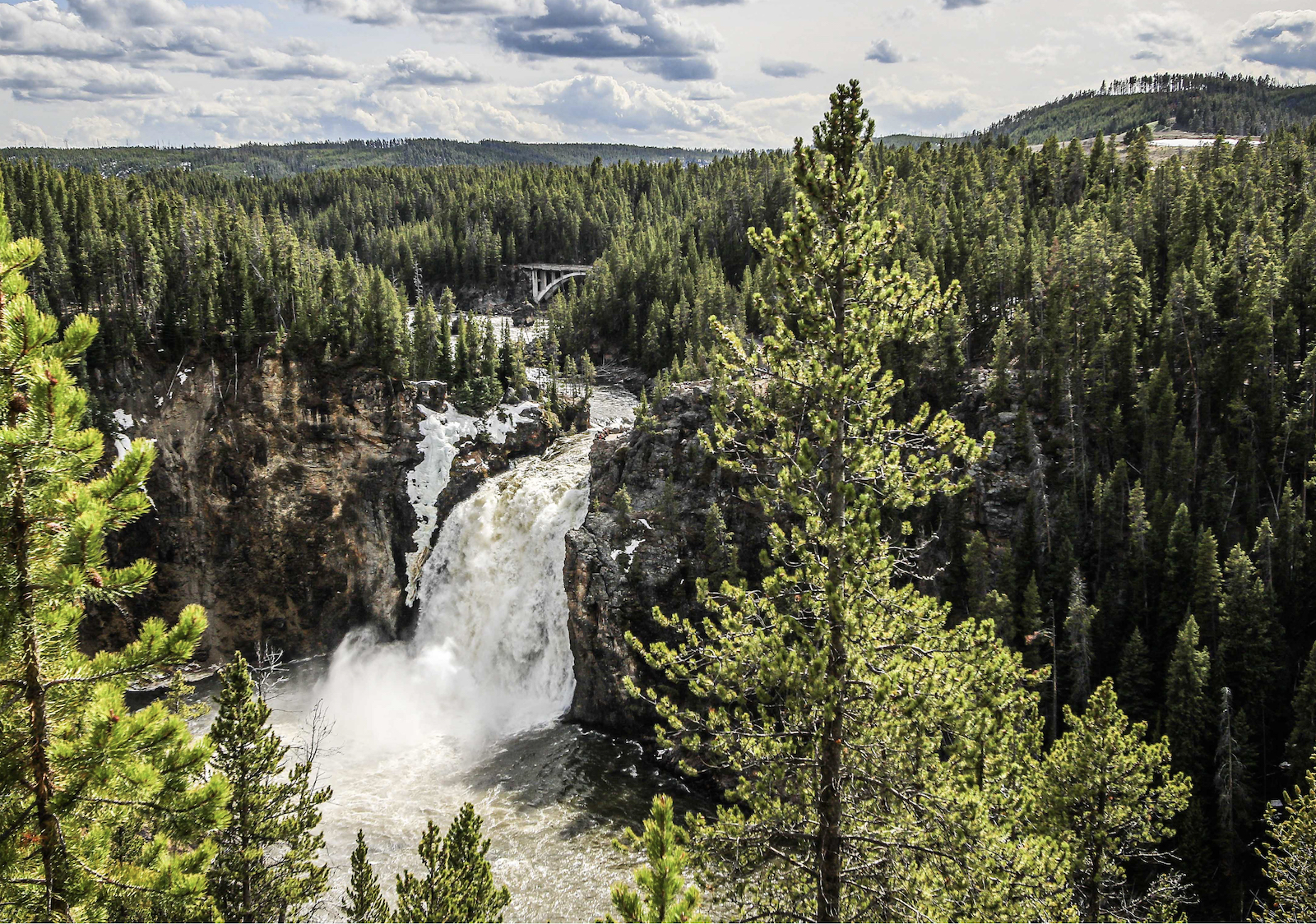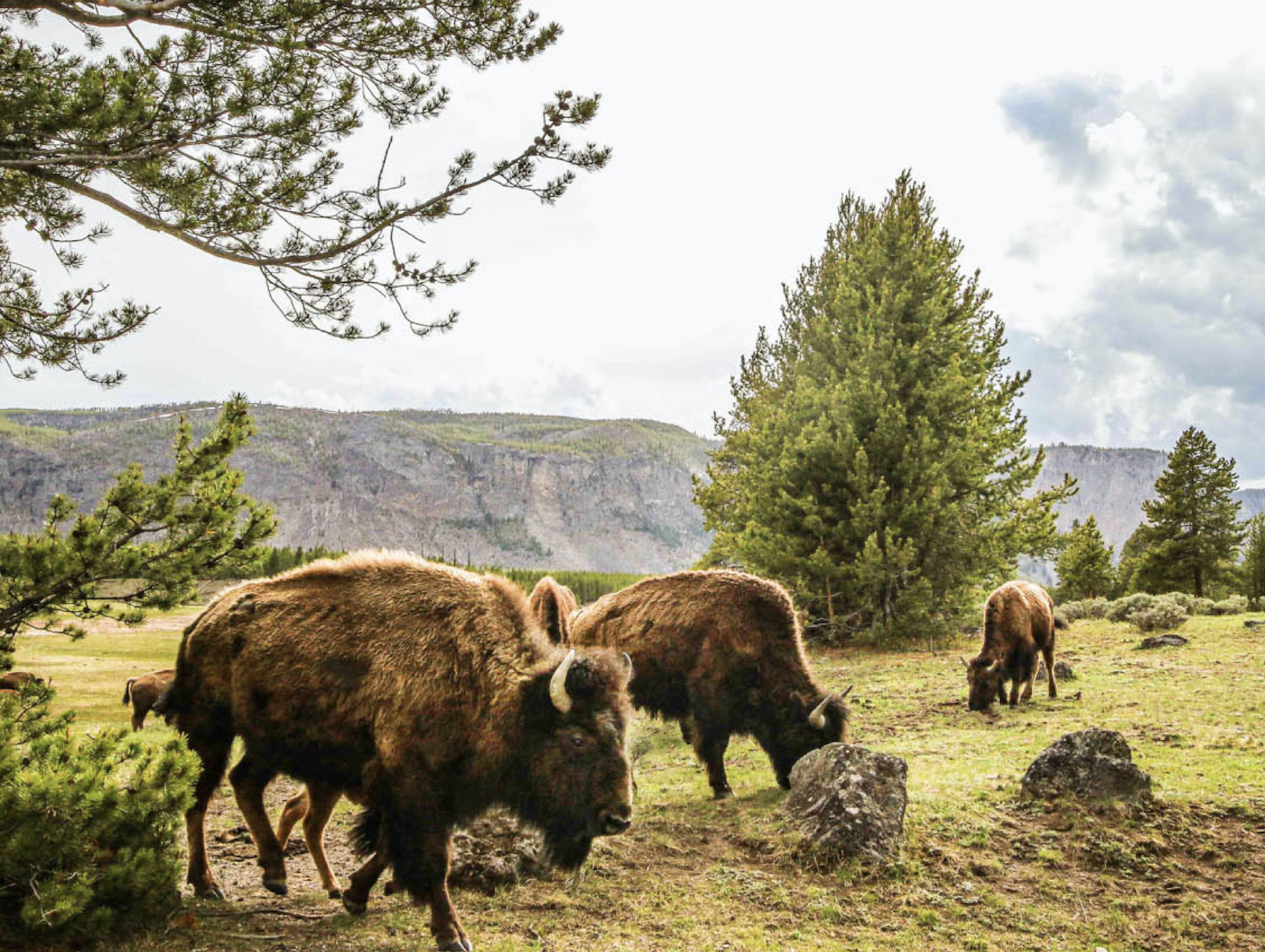Like cows on the streets of Delhi, they stroll unfettered across the road, and a long line of vehicles, shimmering in their own heat, stretches in both directions. They’ve been here a long time, mind, long before roads, long before cars, long before us, in fact, and long, long before the creation of anything called a national park. And like their distant bovine kin, they command a sacred, near-universal respect.
I say near universal, because while everyone else sits stunned, points fingers and cameras, and whispers in wonder, one man swears blindly and lays heavily on the horn of his rusty red Dodge Durango, evidently short on time for this sort of thing. There’s a mother bison blocking his way, standing stone still and straddling the yellow line, her calf nudging and butting her underside for milk.
“Aww, come on!” the Durango driver shouts, bristling behind a salt and pepper beard as he leans out the window. “Let’s get going here!” Clearly, he has somewhere better to be. It is difficult, in this moment, to imagine where.
Bison in North America once numbered in the tens of millions, but suddenly, as European settlers swept the New World in the 1800s, they swept a lot of stuff out of their way, including nearly the entire population of the American bison. By the 1870s, up to two million bison were being eliminated from the plains each year, a staggering 5,000 a day. The eastern invaders were not after the bison themselves. Instead, they recognized that the Indigenous population depended on the animals, and destroying the bison would help force the inhabitants off the land.

Opal Pool, in Yellowstone National Park’s Midway Geyser Basin.
The Blackfoot, Cheyenne, Sioux, and other peoples ate the meat, of course, and made teepees, bags, and baby carriers from the hides, but they also fashioned clubs from the bones and bowstrings from the tendons, made cutlery from the hoofs and horns, wove ropes from the hair, swatted flies with the tails, burned the dung for heat, boiled the cartilage for glue, and decorated themselves with necklaces of teeth. To take the bison away from these people meant taking all that away, too, so after one of the better-known demonstrations of man’s unrivalled flair for rampant and rapid decimation, there were, by 1884, a paltry 325 North American bison left, and just two dozen in the fledgling Yellowstone National Park.
Efforts to save the bison had started a couple of decades earlier, mainly by people who, startled by the nearing disappearance of such a significant beast, started to privately own and care for small herds. These campaigns gradually gained traction, and conversations in the U.S. Congress about conservation in general began to stir. Yellowstone, the first national park in the world, was signed into existence by President Ulysses S. Grant in March 1872.
Bison are the most massive land mammals in the Americas: females can weigh 450 kilograms, and males more than double that.
Continued efforts have brought today’s numbers up to around a half a million in the Lower 48, and about 5,000 graze in Yellowstone, acting like they own the place. That’s because they do.
There are grizzly bears, and wolves too, and while they sporadically make meals of the herd’s young, old, and slow, both are elusive, and neither possesses the ornery, stoic ubiquity of the bison. Nor are they as large. Bison are the most massive land mammals in the Americas: females can weigh 450 kilograms, and males more than double that.

Yellowstone National Park.
Bison are as capricious as they are capacious, and posted around the park’s 8,992 square kilometres is a poster of 16 bison head shots arranged in a grid. Under each is a description of one of the animal’s potential moods to help visitors tell if the creature standing before them is happy or sad, for example. There’s also lonely, mischievous, amused, skeptical, furious, disgusted, romantic, confused, bored, sarcastic, terrified, whimsical, triumphant, and perhaps most fittingly, Mike Tyson-ish. Each photo is a steely, identical copy of the others. Many who have failed to appreciate the poker-faced volatility of the North American bison still bear their scars, if indeed they still have their lives.
But while bison may be the most dangerous animal round these parts, they are by no means the greatest danger. The leading causes of human deaths in the park are similar to those outside the park: car crashes, for example, are a common way to die here, and with great green meadows rolling away under the vast blue sky, along with shooting geysers, steaming ponds, crashing waterfalls, winding rivers, multicoloured pools, and bison absolutely everywhere, it is a harder place than most to keep one’s eyes on the road. Other fatalities include falling off cliffs and accidental drownings. Grimly, about 20 of us have been boiled alive after falling into one of the park’s many thousands of hot, sputtering pools.
Still, the bison should not be counted out and, like us, enjoy their personal space. Many humans who end up gored or trampled simply got too close, leaving their car for a close-up or increasingly, a selfie.

But the armour afforded by a big red American truck can make a man bold. “Aww, come on!” yells the driver of the red Durango, creeping closer to the bison on the road, chewing a toothpick, and clutching the wheel at 10 and two. “Get a move on!” He lays on the horn again.
The mother doesn’t budge, her calf still nursing. She takes a drink from a long, thin puddle in the middle of the road and urinates, with total, magical disregard.
Read more from our Summer 2023 issue.









